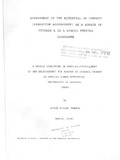| dc.description.abstract | The study was carried out in Gitathuru Approved School, Nairobi,
Kenya. A sample of 85 children (8-13 years) whose haemoglobin level
was <14 gms/dl were identified from a total of 106 children. All
the study subj ects were examined for the presence of parasitic
infestation and later dewormed with mebendazole. Clinical
examinations were carried out. The subjects were randomly
allocated into an experimental group (CCD) whose diet was
supplemented with 10 gms of comfrey powder/day and a control group
(CFD) whose diet was not supplemented. The serum ~-carotene and
serum retinol levels at the baseline and after 21 days of
intervention were determined to assess the potential of comfrey as
a source of vitamin A. Both pre- and post-intervention haemoglobin
levels were not significantly different (P > 0.05)
Analysis of ~-carotene content of fresh comfrey, blanched-oven
dried comfrey powder, and solar dried comfrey powders were carried
out. Storage studies on ~-carotene stability, sieve analysis and
adsorption capacity of comfrey powder were also carried out.
The E,-carotene content of whole unblanched, oven dried comfrey
powder was significantly higher (49.03±0 .14mg/100gms than solar
dried comfrey powder (34.3±1.9mg/100gms) by 30% with P<0.05. The
content of whole steam blanched, oven dried powder was higher than
that of chopped steam blanched powder.
The loss of B-carotene after 5 minutes of cooking comfrey powder
was 4.5% and 21.7% after 7 minutes of cooking.
After 2 weeks of storage of comfrey powder in 200 gauge black
polythene bags at 25°c under CO2, the loss was 27.8% (i.e. from
49.03±O.14 mg/100gms to about 35.4±0.24 mg/100gms) and fell
gradually to about 55% after five weeks of storage.
There were no significant differences in base levels of serum B
carotene and retinol concentrations between the two groups of
children. However, the serum B-carotene levels of the CCD group
(4.99±1.28~mol/l) was significantly higher than those of the CFD
group post intervention (P<O.05). On the other hand post
intervention serum retinol levels for CCD group (0.29±0.18~mol/l)
and those of the CFD group 0.37±0.17~mol/l) were not
significantly different.
Analyses of data and storage studies shows that appreciable amounts
of B-carotene remained, indicate that comfrey powder has a
potential for use in institutions where it can be stored for a
relatively long period of time. The study indicates that further
investigation on the bio-availability and bio-conversion of Bcarotene,
into active form of vitamin A is needed. Nevertheless, it
should be noted increasing B-carotene levels above baseline levels
(4.39±1.28~mol/l) by supplementation is desirable. | en |

